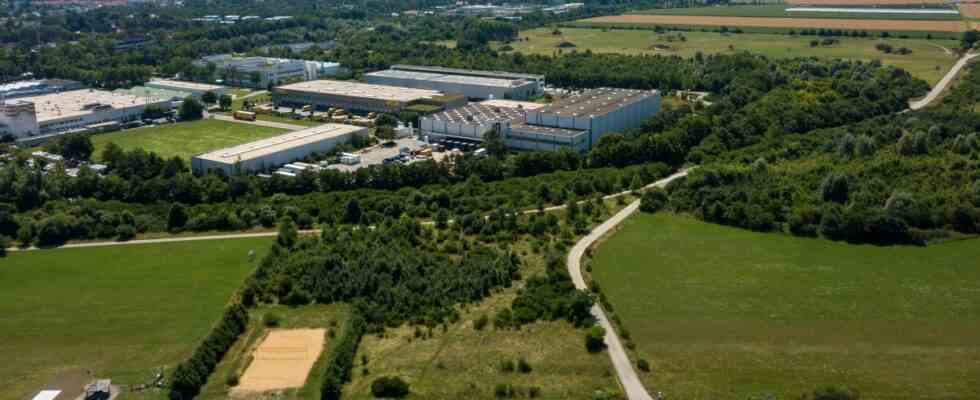The commercial area Northwest in Ottobrunn is to grow. In width as well as in height. And in order to further increase its attractiveness at the location between the state road 2078 and the Finsinger Feld, the area bears the chic name “Campusareal” in the drafts. Because this “urban planning master plan” of Ottobrunn with office towers up to 70 meters high but right next to the landscape park Hachinger Tal is to be realized, the neighboring municipality of Unterhaching is now sounding the alarm and has even hired a law firm. This has written a statement, a clear protest note, which is now delivered to the Ottobrunn town hall after a unanimous vote by the Unterhachinger building committee. There you are surprised and don’t quite understand the excitement.
The paper by the Rittershaus law firm is a tough one, because it already describes the planning of the neighboring municipality as “ineffective”, since “no investigations or even an assessment of the -obvious -significant effects on the basic urban planning concept of the Hachinger Tal landscape park have taken place”. This was absolutely necessary because the current planning would destroy the basic urban concept of the landscape park, write the lawyers.
In the 19-page letter, the residents of Ottobrunn are reminded of the planning principles. The landscape park was about the “creation of a near-natural, extensive local recreation area for the neighboring communities and the districts of the south-east of Munich”. Also important is the “continuation and interweaving of the existing and planned green areas of the state capital Munich in the surrounding area as well as the “security as a large-scale connected retreat for animal and plant species displaced by intensive land use with “leeway” for natural succession” but also a concentration of the extensive , natural local recreation in the core zone east of the autobahn and the more intensive, more sporty types of recreation west of the autobahn.
The landscape park is used for local recreation and nature, warns the municipality of Unterhaching.
(Photo: Angelika Bardehle)
It was important to the planners in 1992 that those seeking relaxation in the landscape park experience the vastness of nature, that when the foehn wind blows, even the mountains in the south are within reach. Therefore, the visitors should deliberately not notice any buildings in the area of the landscape park, so that they feel like they are in the great outdoors. If Ottobrunn now builds its planned office towers directly on the edge of the area, in Unterhaching all this is in danger. There, the neighbors are sharply criticized because they have insufficiently addressed the environmental concerns of the landscape park or have postponed them to a later date. Above all, the protected areas, the existing animal world and the light emissions in the landscape park were not taken into account enough from Unterhachinger’s point of view.
In addition to environmental protection, the municipality of Unterhaching is also concerned with the increase in traffic and settlement pressure. 5,000 people are said to work on the approximately 19-hectare “Campusareal”. It is to become an office and technology location where the investor can also imagine gastronomy and cultural uses. At the suggestion of the lawyers commissioned by Unterhaching, Mayor Wolfgang Panzer (SPD) will now commission various reports to examine both the traffic and the nature conservation effects of the Ottobrunn plans. Unterhaching also wants experts to examine the effects on urban development.
The landscape park is also an attractive area for athletes.
(Photo: Angelika Bardehle)
Ottobrunn’s Mayor Thomas Loderer (CSU) is not very surprised about the reaction of the municipality of Unterhaching, but that they immediately consulted a lawyer. As early as spring, Loderer emphasizes, he invited Panzer and Neubiberg’s town hall chief Thomas Pardeller (CSU) to a joint meeting to inform them about the plans for Finsinger Feld. Not in order to convince them, he says, “but in the interests of transparency.” He himself and the Ottobrunn municipal council are “unanimously” behind the project – in terms of its size and amount, says Loderer.
For many Ottobrunn residents, Finsinger Feld seems like a small exclave of the municipality, as it is separated from the main town by the state road and the Haidgraben – but in future it is to be connected to Ottobrunn by a “spectacular pedestrian and cyclist bridge”, as Loderer emphasizes. This is an important measure in terms of urban development, which can also be carried out without taking up space, since the area is already built on. “The project is important for Ottobrunn. And we simply belong to the urban space and are also committed to it,” Ottobrunn’s mayor defends the planned high-rise buildings, which he believes would not endanger the biodiversity in the landscape park and its importance as a local recreation area. It is clear, says the mayor, that the area will have a “completely different character” and that the project will also result in an increase in traffic – not for Unterhaching, but rather east of the autobahn for Ottobrunn and Neubiberg. In order to be able to cope with this increase, however, one must also think beyond community boundaries, says Loderer, and the subway, which will once run near Finsinger Feld, could also play a role.

